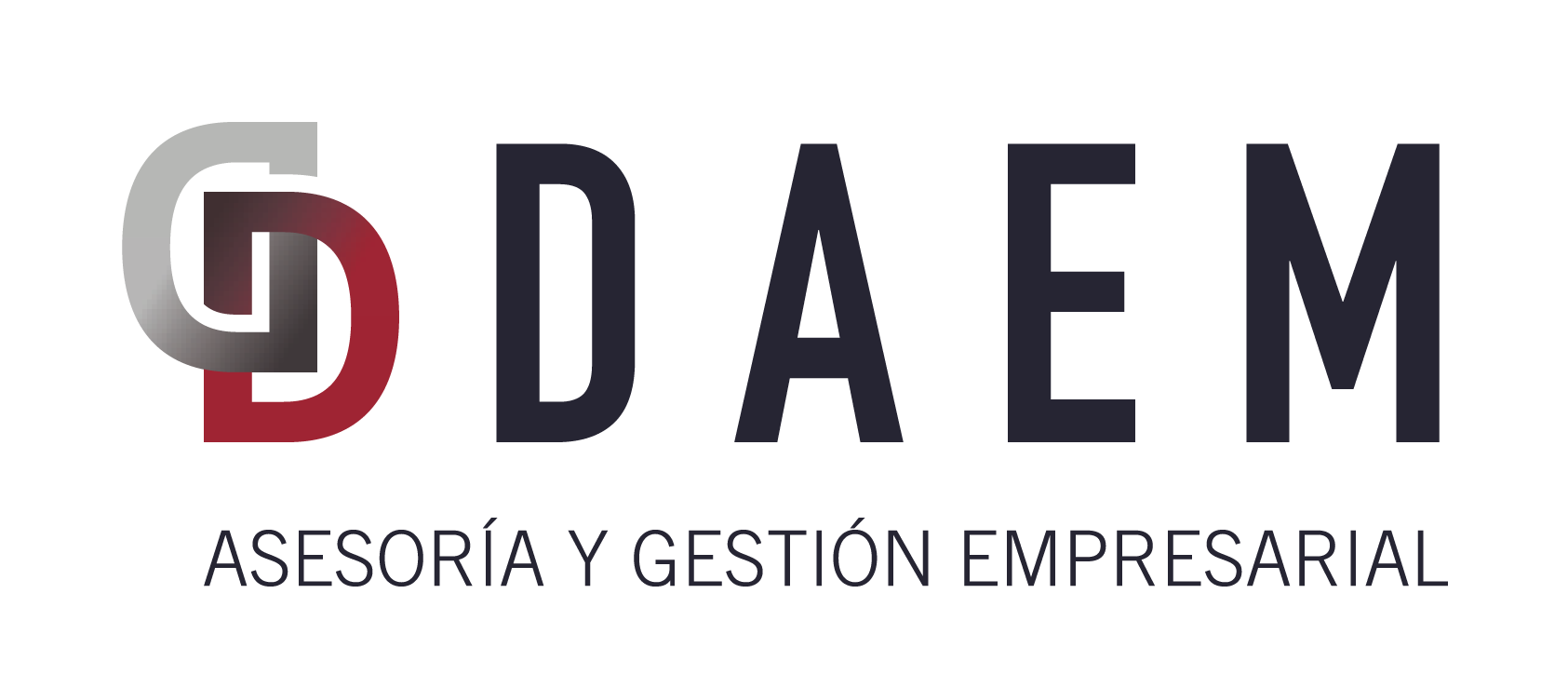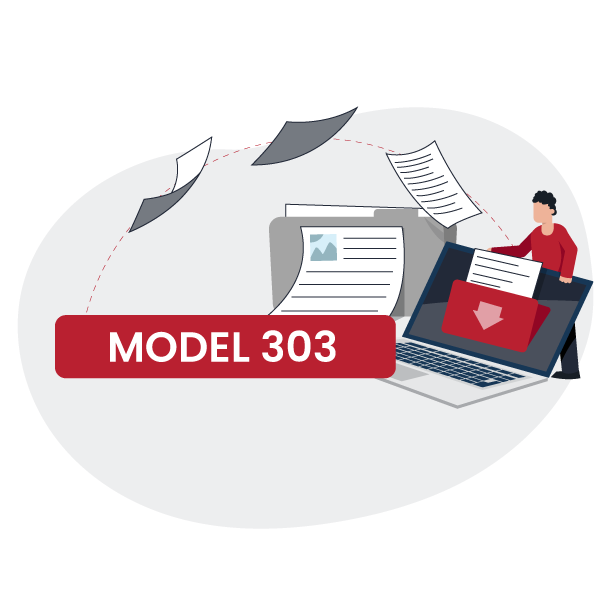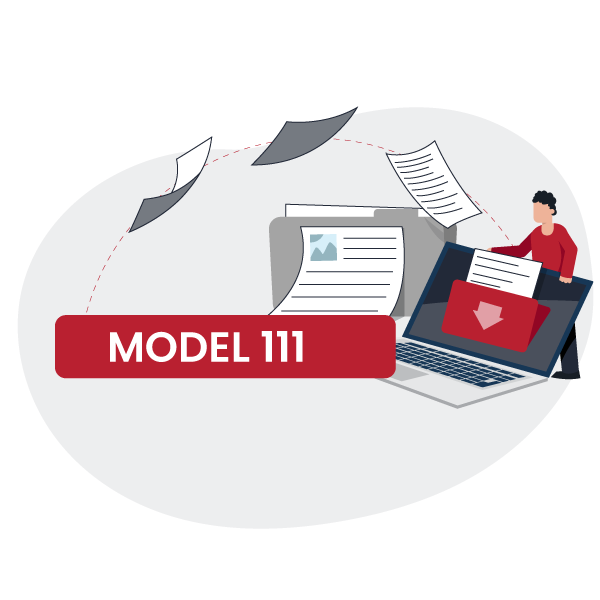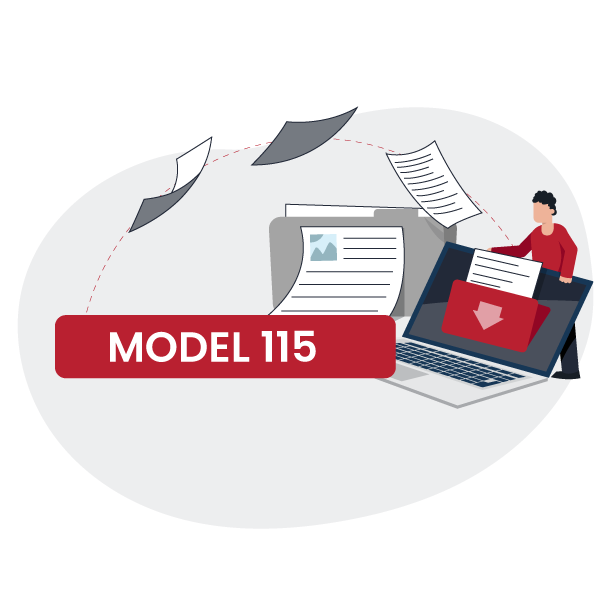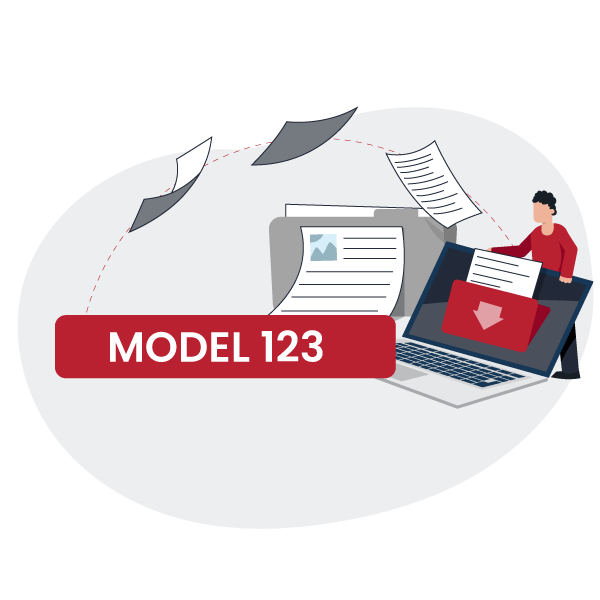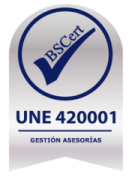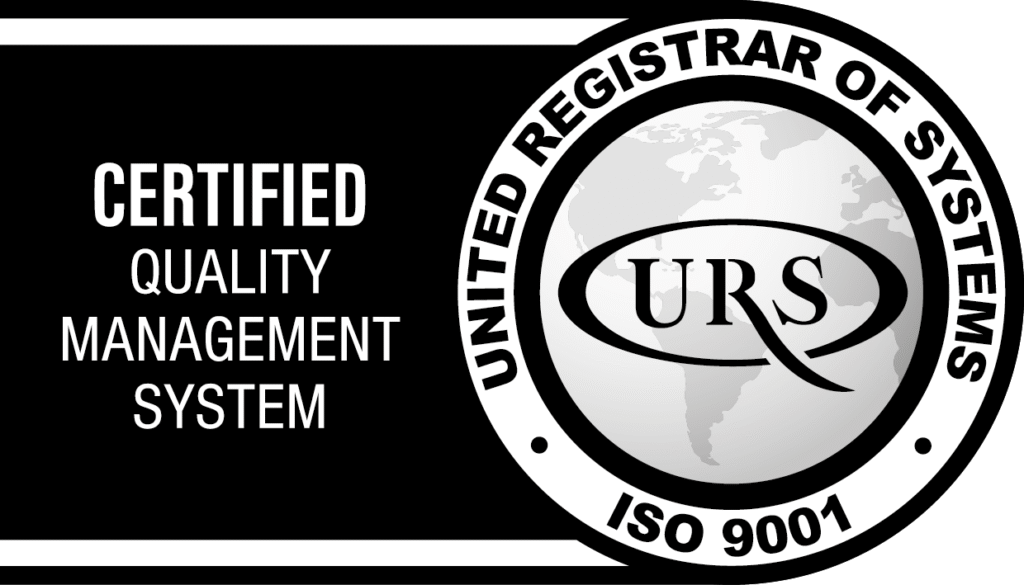Do you want to know about the Tax Agency’s Model 303? We’ll explain who is obliged to submit it, when the deadlines are, what the consequences are of submitting it late, and whether it can be postponed.
If you are a freelancer or represent an SME, the information in this article will be of great interest to your business.
If you need help with any of the tax forms that need to be submitted to the Tax Agency, don’t hesitate to contact us. At DAEM, we are tax experts and will help you avoid penalties that could jeopardize your business.
What is Model 303?
This document is generally a quarterly tax obligation to settle Value Added Tax (VAT) with the Treasury. With it, you pay the Tax Agency the VAT you have collected through invoices issued to your clients.
VAT is a tax paid by the consumer, and you, as a self-employed worker or company, act as a collector. In the usual operation of a business, VAT is presented in two forms:
- Output VAT (VAT charged/accrued): The VAT you add to your invoices for your clients to pay.
- Input VAT (VAT borne): The VAT you pay when acquiring products or services from third parties.
All this is done with the purpose of paying it to the Tax Agency, fulfilling an intermediary role. It is, without a doubt, one of the most important and, sometimes, most complex taxes to submit.
Don’t worry, if you contact our tax advisory service, we can give you a hand.
What types of results can be obtained when settling Model 303?
When settling VAT, the result can be:
- Positive: You owe money to the Treasury. If you have direct debit, it will be charged on the last day of submission (the 20th of each month or the 30th in January). Otherwise, the charge will be at the time of voluntary payment.
- Negative: This results in a balance in your favor that you can request to offset. Thus, that money will be “saved” for the next quarter, and you can deduct it from the amount to be paid. If the VAT continues to be negative in subsequent quarters, you will accumulate a balance in your favor. The VAT refund can only be requested in the last quarter of the year (by submitting Model 303 for the fourth quarter in January of the following year). The Treasury has a maximum period of 6 months to make the refund, after which interest will accrue in your favor.
- Zero: The result of the settlement is neutral. Even so, submitting Model 303 is mandatory, as it is a formal obligation.
One of the most common problems for business owners is knowing whether they can deduct input VAT on certain expenses, as personal expenses are often mixed with business ones. For expenses to be VAT deductible, they generally must meet the following requirements:
- Be linked to the economic activity of the company.
- Be duly justified (e.g., with the corresponding invoice).
- Be correctly recorded in the accounting and ledgers.
What VAT categories are used in Spain?
In Spain, there are three types of VAT, depending on the activity:
- General: 21%.
- Reduced: 10%.
- Super-reduced: 4%.
The reduced and super-reduced rates apply exclusively to operations expressly and limitedly enumerated by law. Other operations are taxed at the general rate.
The main activities that, as a general rule, apply the Reduced VAT (10%) include:
- Hospitality, spas, restaurants, and the supply of food and beverages for immediate consumption (excluding alcoholic beverages and tobacco).
- Water suitable for human or animal consumption or irrigation.
- Flowers, plants, seeds, bulbs, cuttings, etc.
- Services to owners of agricultural, forestry, or livestock farms (planting, sowing, fertilizing, etc.). Transfers of use or leasing are excluded.
- Services for the collection, storage, transport, recovery, or disposal of waste, sewer cleaning and deratization, and collection of wastewater.
- Passenger and luggage transport.
- Entry to libraries, archives, documentation centers, museums, art galleries, pinacothecas.
- Amateur sporting events.
- Exhibitions and trade fairs.
- Renovation and repair works in homes (with some exceptions at 21%).
- Lease-to-own agreements for homes (including up to 2 parking spaces and annexes).
The main activities that, as a general rule, apply the Super-reduced VAT (4%) include:
- Products: Common bread, bread flours, milk, cheese, eggs, fruits, vegetables, legumes, tubers, and cereals.
- Books, newspapers, and magazines that do not contain only advertising and their supplements.
- Medicines for human use.
- Vehicles for people with reduced mobility and wheelchairs for the exclusive use of people with disabilities.
- Vehicles intended for taxis or special cars for the transport of people with disabilities in wheelchairs, as well as motor vehicles that regularly transport such users or those with reduced mobility.
- Prostheses, orthoses, and internal implants for people with disabilities.
- Official protection housing of a special regime or public promotion, including garages and annexes in the same building.
- Repair services for vehicles and wheelchairs for people with disabilities and adaptation services for the aforementioned taxis and cars.
- Lease-to-own agreements for buildings or parts thereof intended solely for official protection housing of a special regime or public promotion.
- Telecare services, home help, day and night centers, and residential care for dependent persons.
Who must submit Model 303?
Almost all freelancers and companies in Spain must submit Model 303. This includes all those who carry out an activity subject to VAT. If you issue invoices to your clients, you must consider Model 303 in the following situations:
- If you have had no activity during a quarter or if the result between output and input VAT is 0, provided you are registered for a VAT-subject activity.
- If the result is positive and you need to pay.
- If the Treasury owes you money, but you decide to offset it with the next quarterly declaration.
- If the fourth-quarter declaration is in your favor, and the Treasury must refund you money.
You must also fill out Model 303 if you rent a premises or apartment used as a place of work.
When should Model 303 be declared?
The Model 303 declaration is quarterly. The deadlines are:
- First quarter: from April 1st to 20th.
- Second quarter: from July 1st to 20th.
- Third quarter: from October 1st to 20th.
- Fourth quarter: from January 1st to 30th.
If the deadline falls on a holiday or weekend, it is extended to the next business day. If you choose to direct debit the payment, the submission deadline will be 5 days before the dates established in the tax calendar.
What are the criteria for monthly submission of Model 303, and in which cases is it advisable?
Companies that bill more than €6,000,000 (in the previous year) are obliged to submit the VAT declaration (Model 303) monthly on the 20th of each month, under the Monthly VAT Refund Regime (REDEME). Additionally, they must register the VAT ledger (Immediate Supply of Information or SII) almost immediately on the Tax Agency’s website.
On the other hand, many companies are unaware that they can voluntarily join REDEME. It can be interesting if one wants to avoid the financial cost of deferring the receipt of refunds (which can only be requested once a year quarterly), especially when:
- Significant investments are made in certain periods.
- At the start of an activity, when expenses exceed income.
- Due to the company’s own activity (e.g., export), more input VAT is generated than output VAT.
To enter this system, you must register the company in REDEME and submit Model 340 (Informative Declaration of operations in VAT ledger books) monthly, which includes a list of all invoices issued and received. This is not necessary if you are already registered in the SII, which reports VAT books to the Tax Agency almost immediately.
Among the advantages of this system are:
- Greater liquidity: It’s possible to recover VAT monthly when the declaration is in your favor, instead of annually.
- Avoid errors in invoices: Monthly submission allows for quick detection and correction of errors, reducing potential penalties.
Among the disadvantages of this system are:
- Increased administrative burden and costs: Monthly VAT declarations (Model 303) and the VAT ledger (Model 340) must be submitted. Furthermore, the SII requires constant communication with the Tax Agency.
- Lower liquidity in case of a result in favor of the Treasury: Instead of paying quarterly, payment will be made monthly.
It is important to evaluate the balance between the benefits and drawbacks of this system. Although it is more designed for large companies or those with high export activity, significant investments, or habitually more input VAT than output VAT, not all companies can opt for REDEME. Only those that meet these requirements:
- Be up to date with their tax obligations.
- Not be in any of the situations that could lead to precautionary deregistration from the monthly refund register or revocation of the tax identification number.
- Not have been excluded from the Register in the 3 years prior to submitting the registration application.
If the company meets these requirements, it can file its monthly VAT return. To do this, it must apply for registration in the register in November (for application the following year) by submitting Model 036 (census declaration). If it was not submitted in November, registration can be requested during the period for submitting periodic self-assessments (between the 1st and 20th of the month in which the corresponding VAT settlement must be submitted). The deadline for resolving the registration application is three months, and administrative silence is negative.
What happens if I don’t submit Model 303 on time?
If you realize and submit Model 303 late, you will incur surcharges. These surcharges are a fixed 1% plus 1% for each month of delay. If the delay exceeds 12 months, the surcharge increases to 15%.
If it is the Tax Agency that detects that you have submitted it late, the penalties will be higher, classified by the body as minor, serious, or very serious, depending on the severity of the infraction committed.
What is the procedure for postponing the payment of Model 303?
It is not uncommon for a freelancer or a company to have to pay the VAT on their invoices, but the amounts have not been collected from their clients. This, of course, harms the business, as it would have to “advance” the money.
In this case, the Tax Agency does offer the possibility of postponing VAT payment.
- If the amount is less than €50,000, it is not necessary to provide guarantees for the Tax Agency to grant the postponement.
- If the amount is greater than €50,000, you must provide a guarantee.
To postpone payment, the same model is submitted, but you must select the “Recognition of debt with request for postponement” option. Then, you will have to process it and indicate a payment schedule to the authorities.
This process can be somewhat confusing and complex. Our recommendation is that you consult your DAEM tax advisor to help you with the process. From DAEM, we can also guide you and carry out some procedures on your behalf to avoid larger economic penalties.
What is the equivalence surcharge and what are its implications for my VAT declaration (Model 303)?
The equivalence surcharge is a special VAT regime that affects retail traders. It does not apply to limited companies, but it is important to know about it. This regime is mandatory for self-employed retailers who meet the following conditions:
- They carry out the economic activity on their own account, buying goods to sell them without manufacturing, modifying, treating, or transforming them.
- 80% of the total sales operations carried out in the previous year must have been to clients who are not entrepreneurs or professionals.
- They do not develop or sell certain specific products or services (such as automobiles, jewelry, petroleum products, etc.).
For freelancers under this regime, VAT management is simplified, as they do not have to submit their quarterly declaration (Model 303). For each purchase they make, they directly pay their supplier a VAT surcharge that varies depending on the product.
If you have clients who meet these characteristics, you must include in the invoice for the products you sell the corresponding VAT amount plus the equivalence surcharge. You will be the one who, by submitting your Model 303, pays the VAT to the Treasury for the products your client will sell to the final consumer.
The equivalence surcharge to be applied, depending on the VAT rate of the product or service, is:
- 21% VAT: 5.2% surcharge.
- 10% VAT: 1.4% surcharge.
- 4% VAT: 0.5% surcharge.
- Tobacco: 1.75% surcharge.
Although your client will not report on this specific case, if you suspect that a client may be under the equivalence surcharge, it is better to make sure before issuing the invoice, as you are the one issuing it.
What is Model 390 and what kind of relationship does it have with Model 303?
In addition to the quarterly declarations, we have the obligation to submit annually, between January 1st and 30th, an informative declaration with the annual VAT summary. This is Model 390, and it includes the total operations subject to this tax throughout the fiscal year, regardless of the amount declared.
It is very important that this informative declaration matches the four quarterly Model 303 declarations submitted during the fiscal year, as any inconsistency will be a reason for verification by the Tax Agency.
At DAEM, we strive to provide accurate and up-to-date information in our articles and publications. However, it is important to note that the complexity of tax matters can vary and be subject to regulatory changes. We want to emphasize that, although we strive to offer quality content, we do not assume responsibility for inaccuracies or omissions that may arise. In tax matters, expert guidance is fundamental to adequately address the specificities of each case.
